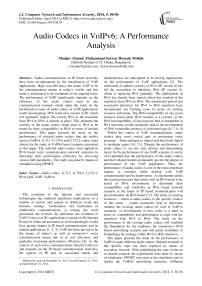Audio Codecs in VoIPv6: A Performance Analysis
Автор: Monjur Ahmed, Mohammad Sarwar Hossain Mollah
Журнал: International Journal of Computer Network and Information Security(IJCNIS) @ijcnis
Статья в выпуске: 5 vol.6, 2014 года.
Бесплатный доступ
Audio communications in IP based networks have been revolutionized by the introduction of VoIP applications. High cost-efficiency has made VoIP to be the communication means in today’s world; and this trend is anticipated to be continued on an ongoing basis. The performance of VoIP significantly depends on the efficiency of the audio codecs used in any communication scenario which make the study on the performance issues of audio codecs in VoIP applications worth investigating. IPv6 is the new version of IP, which will gradually replace the current IPv4 as the transition from IPv4 to IPv6 is already in place. This demands the scrutiny of the audio codecs being used in IPv4 to be tested for their compatibility in IPv6 in terms of desired performance. This paper presents the study on the performance of selected audio codecs that are widely used in VoIPv4. G.711, G.729A and G.723.1 codecs were chosen for the study in VoIPv6 based scenarios presented in this paper. The selected audio codecs were applied in IPv6 based voice communication network scenarios to determine their performance efficiency by observing various QoS parameters. The study was done by means of simulation using OPNET.
Audio codec, G.711, G.729A, G.723.1, IPv6, QoS, VoIP, VoIPv6
Короткий адрес: https://sciup.org/15011304
IDR: 15011304
Текст научной статьи Audio Codecs in VoIPv6: A Performance Analysis
Published Online April 2014 in MECS
The evolution of the Internet and associated technologies has imposed significant implications on a number of sectors and aspects in different social and business settings. Acceleration and facilitation of multimedia communications is among the most prioritized one of these. By definition, the evolution of VoIP (Voice over IP) applications is based on IP (Internet Protocol) where advancement in such technologies would have greater impact in IP based communications and its related applications [1, 2, 3]. VoIP has been proved to be the means of today’s as well as tomorrow’s voice communication means due to its cost efficiency and gradually increasing performance efficiency [4]. As the context of such voice communications directly relates to and depends on the IP based communication networks, the aspects of IP and its associated trends and
Manuscript received December 16, 2013; revised January 22, 2014; accepted January 31, 2014.
characteristics are anticipated to be having implications on the performance of VoIP applications [5]. The realization of address scarcity of IPv4 (IP version 4) has led the researchers to introduce IPv6 (IP version 6), which is replacing IPv4 gradually. The deployment of IPv6 has already been started which has resulted in the transition from IPv4 to IPv6. The transitional period and associated initiatives for IPv4 to IPv6 transition have incorporated one burning issue in terms of existing resource utilization. The IPv6 compatibility of any given resource tested under IPv4 scenario is a concern, as the IPv6 incompatibility of any resource that is compatible in IPv4 networks would essentially lead to the development of IPv6 compatible resource of concerned type [6, 7, 8, 9].
Within the context of VoIP communications, audio codecs play most crucial part in processing voice elements – from analogue to digital and then from digital to analogue again [10, 11]. Though the performance of audio codecs is not the only driving and determining factor for the performance of any VoIP scenario, it can be well admitted that the performance of the audio codecs and their related features dominantly govern the degree of performance of any VoIP application. Thus, the performance of audio codecs is one of the most important aspects to consider while dealing with VoIP communication and its deployment. As mentioned earlier, the existing resources that works well on IPv4 needs to be tested in IPv6 environment to determine their compatibility and suitability in IPv6 based network scenario as the future of IP based communication will pre-dominantly be IPv6 based [12]. The study of existing resources – which is audio codecs in the specific context of this study – would essentially help to determine whether the existing audio codecs fit well in VoIPv6 scenarios, or development of new codec is a must in terms of compatibility and performance to cope with the transition from IPv4 to IPv6. The study on the performance of the existing audio codecs will establish the foundation for the readiness for tomorrow’s IPv6 based networking scenario and will partly contribute in formulating the strategy within IPv4 to IPv6 transition.
This paper presents the study on the performance of VoIPv6 under different audio codecs. Related research in this specific topic has been explored by means of secondary research. With establishing the state-of-the-art of related research, the experiments were done by means of simulation. OPNET was used as the simulation tool to deploy the VoIPv6 networking scenarios. Different networking scenarios were configured with different audio codecs to be experimented; and major performance indicator parameters were determined to be observed to collect the performance statistics. Based on the simulation results and the performance trend analysis of the different audio codecs used in the experiment, it was subsequently possible to analyze and decide on a level of performance for different audio codecs in the specific VoIPv6 network scenario used in the experiment. The provision of further research in relation to the presented study has also been addressed.
The organization of the contents of this paper is done under six sections. The first section or the introduction presents the background information on the research domain. ‘Related Works’ section is the literature review to present the state-of-the-art on the research topic. Section three is named as ‘simulation’ where the simulation environment setup is discussed. This section outlines the configuration scenario and well as various parameter and other technical details of the audio codecs used in the study. The obtained results on the selected parameters are discussed in the ‘results’ section. In the following section ‘analysis of the results’, the interpretation on the obtained results in line with research interest has been addressed. The last section presents the concluding remarks on the research conducted, and the scope of further development of the research study presented in this paper.
-
II. Related works
The introduction of IPv6 has already ensured that the future trends in IP-addressing within networking and communications context will be based on IPv6 [12]. The improvement of audio and video based communication technologies will be required to have improvement with the introduction of IPv6 [9]. The scarcity of address allocation capability of IPv4 has brought forward the requirement to think alternatives, where the introduction of IPv6 is the consequence of such limitation of IPv4. The already started transition from IPv4 to IPv6 for the IP based networks and related communication scenarios has already made it a reality that a total transition to have a global IPv6 based network is to be achieved in course of time, and in an inevitable manner. One of the important aspects between IPv4 and IPv6 is their mutual incompatibility [6, 7]. As a result, the transition would also include the associated applications within the context of concern. VoIP is a prime application in this context. The heterogeneous nature of future networks would also bring VoIP under the spotlight to scrutinize its performance in IP networks as well as other types of hybrid networks [1]. When VoIP is considered, its underlying performance factors and the driving influence of the codecs and their implications must also be taken into account – finding a suitable audio codec for any given VoIP scenario is thus important [13]. The QoS related performance level might greatly be influenced by and dependent on the audio codec used for VoIP communication; though the total performance and quality experience might not solely depend on the audio codecs used. A number of different factors, networking elements and configuration of any given scenario would have to be taken into account in respect to the performance determination of any IP based communication network. Audio codecs are very important in VoIP based on the fact that the QoS aspects of the used codecs impact the quality of IP based audio communications [5, 9, 10]. As a result, the quality of performance in VoIP is dependent on the efficiency of the audio codecs [10]. The efficiency of the audio codecs is defined by its QoS (Quality of Service) parameters. QoS parameters are the indicators for any given audio codec to be judged on its degree of efficiency. For this reason, the observation and study on the QoS parameters could be a potential indicating point on the level of performance for an audio codec [10, 14, 15, 16]. QoS related requirements and subsequent performance is the most prioritized one for VoIP applications [17]. The specific scenarios of IP based communications have a number of parameters that collectively defines the context of QoS – MOS (Mean Opinion Score), jitter, end-to-end delay and packet delay variation are important parameters that fall within this category [16, 18, 19]. MOS is an indicator to assess the quality of voice calls; jitter is also used to indicate the level of quality [1]. MOS is considered to be the standard metric for determining the efficiency of audio codecs in VoIP where a scale of 0 to 5 is used; 0 being the worst and 5 the best quality of voice processed by the respective codec [19]. MOS, jitter and various delays are the major parameters in terms of VoIP QoS that are widely used as performance and efficiency indicators; though the total performance of a VoIP network would depend on other factors, for example, network capacity and traffic load [9, 10, 11]. Jitter and various delays can potentially be used to point to the efficiency of audio quality. Besides, MOS is very important value to determine in this regard [15]. The overall quality of service for any VoIP application depends on parameters like MOS, Jitter and delay along with other configuration based parameters [16]. G.711, G.729A and G.723.1are some of most widely used audio codecs in VoIP [20]. In wireless scenarios, some researchers found G.711 to be best in terms of MOS and G.729 to have least delay [21] – a crucial observation to denote the fact that the level of performance for different audio codecs might depend not only on the efficiency of the audio codec of interest itself, but also on other factors and elements for any given network scenario in terms of networking elements as well as the soft configurations. Signalling protocols used in IP based voice communications are of noteworthy importance. One widely used signalling protocol is SIP (Session Initiation Protocol). Due to the requirement of SIP protocol, the performance of G.729A for real time applications like VoIP has not been up to the mark [22]. This leaves the room for different signalling protocols to be coupled with different audio codecs to determine performance level of audio codecs in VoIP communications settings. For the specified audio codecs, the performance degradation in the form of decreasing
MOS value and gradually increasing rate of data loss might be experienced if the load on any given network is gradually increased – G.711 has been found to be best codec in terms of MOS value where it has a MOS value of 4.195 [17]. Some study argue that low bit rate codecs like G.729A and G.723.1 performs better compared to other higher bit rate codecs [10]. OPNET simulation tool is a popular one in research and academia with high level of preference compared to other simulation tools used. Feature richness of OPNET is one of the influential factors that have made this simulation tool to be the most popular one for research in relevant fields. The unique features of OPNET are in its richness in terms of configuration capability, network protocols as well as its GUI interface. The results obtained by OPNET simulation is considered to reliable and very close to the real life results [18]. The use of OPNET simulation tool for network performance studies has been carried out by numerous research studies [5, 11, 12, 14, 16, 18, 21] which essentially establish the credibility of OPNET to be used as the simulation tool.
-
III. Simulation
The setup and configuration of the networking scenario was done by means of simulation. OPNET was chosen as the simulation tool. OPNET simulation tool was chosen for its global recognition in terms of reliability and consistency in producing results very close to real life scenario – the credible aspects of OPNET to consider it as the best simulation tool has already been discussed. The initial step was involved in developing and deploying a suitable network topology in the simulation environment. Proper parameters for the network topology (e. g. audio codecs and their associated parameters, signalling protocol, queuing mechanism) were determined to configure the network scenario. The statistics to be collected for performance analysis was a crucial part to determine due to the fact that the analysis of this study was dependent on the analysis on the collected statistics. The collection of the performance statistics from network simulation subsequently helped to analyze the performance of the selected audio codecs; which in turn assisted to reach a decision relevant to the study. Once the simulation had been carried out and data samples were collected on the chosen parameters, the statistical analysis helped to determine the value of the parameters; the values then compared to the standard benchmarking values to decide the level of performance of any given audio codec with respect to a specific parameter.
-
A. Topology and configuration
The deployed topology for the simulation environment is shown in Fig. 1. The network topology shows the networking elements used along with their interconnections. The application, profile and QoS profile implementation were required to done as part of the scenario wide standard policy implementation in OPNET.
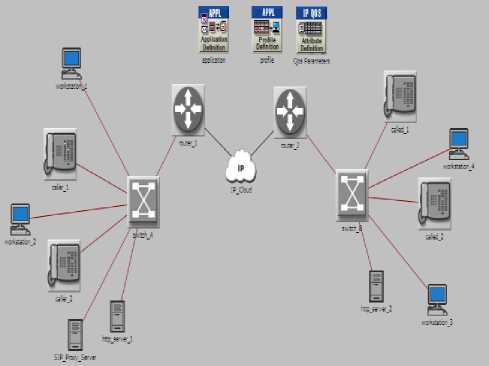
Fig 1. Network Topology
The topology was consisted of two networks connected through IP cloud by means of routers. Two IP phones were used as the callers in one network and another two IP phones were used as called in the other part. SIP was used as the signalling protocol which required the network architecture to have SIP proxy server. HTTP (Hyper Text Transfer Protocol) servers and clients were used to generate background traffic to behave the network like a real life one where heavy HTTP traffic load were configured. This had resulted in creating two applications for the operational network to generate traffic – voice application and HTTP application. The whole network was configured with IPv6 as this was the preliminary criteria to achieve the objectives set for the conducted study. As part of QoS parameter, protocol based CBWFQ (Class Based Weighted Fair Queuing) was chosen and implemented on a global basis - that is, applicable to the whole network scenario. The routers were connected to the IP cloud by PPP DS link which has 1.544 Mbps capacity; the switches were connected to the routers by 100BaseT Ethernet cables that are of 100Mbps capacity, and the 10baseT of 10Mbps capacity Ethernet link was used in the LANs that were under each switch. All links used in the network scenario were full duplex. Three audio codecs named G.711, G.729A and G.723.1 were chosen for the study. The configuration for the codecs used in the deployed VoIPv6 scenario is summarized in table-1.
Table 1. Configuration parameter for audio codecs
|
Codec Name |
Type |
Coding Rate |
Frame Size |
Look ahead Size |
|
G.711 |
PCM |
64 Kbps |
10msec |
0 msec |
|
G.729A |
CS- ACELP |
8 Kbps |
10msec |
5 msec |
|
G.723.1 |
ACELP |
6.3Kbps |
30 msec |
7.5 msec |
-
B. Scenarios and statistics
The chosen three audio codecs were studied in a VoIPv6 network scenario using SIP signalling protocol. This led to the requirement of creating three different network scenarios. The first network scenario was the deployment of G.711 over SIP in a VoIPv6 environment, the second scenario involved in using G.729A audio codec over SIP in a VoIPv6 environment; and G.723.1 audio codec over SIP in a VoIPv6 environment was used in scenario three. Deciding on the QoS statistics to be collected on the parameters from the simulation was done to meet the requirement that would help to indicate the performance aspects of the audio codecs. The statistics that were collected from the simulation were MOS, Jitter, End-to-End packet delay and packet delay variation. The analysis of the aforementioned parameters would potentially indicate the degree of performance of the audio codecs over IPv6 based voice communication.
-
IV. Results
-
A. MOS
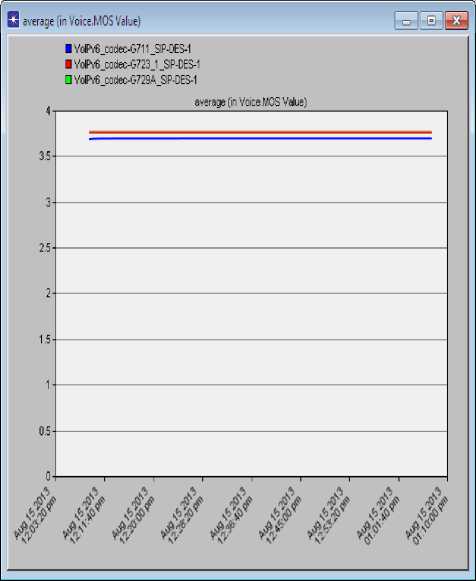
Fig 2. MOS Value
The MOS value for the codecs collected from simulation is shown in Fig. 2. The observation showed that G.711 had lowest MOS value which was close to 3.7. G.723.1 and G.729A had higher MOS value which was close to 3.8.
-
B. Jitter
The observation on jitter for the audio codecs is illustrated in Fig. 3. The collected statistics as depicted in Fig. 3 shows that G.711 was least affected by jitter where the other two had higher impact of jitter than that of G.711, which was also associated with random jitter at the beginning of network transmission.
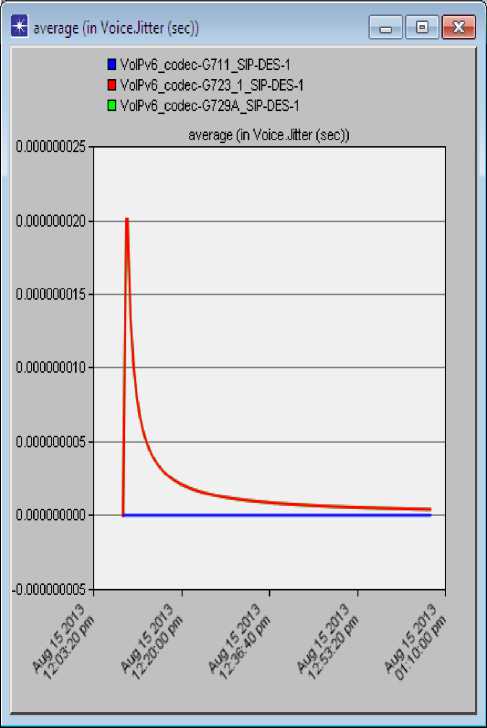
Fig 3. Jitter
-
C. End-to-End delay
Fig. 4 portrays the End-to-End delay of the audio codecs. The result indicated a higher packet end-to-end delay for G.711 which was around 0.061 sec. The delay for both G.723.1 and G.729A was around 0.049 sec.
-
D. Packet delay variation
The results on packet delay variation for the audio codecs were as illustrated in Fig. 5. The packet delay variation was found to be lowest for G.711.
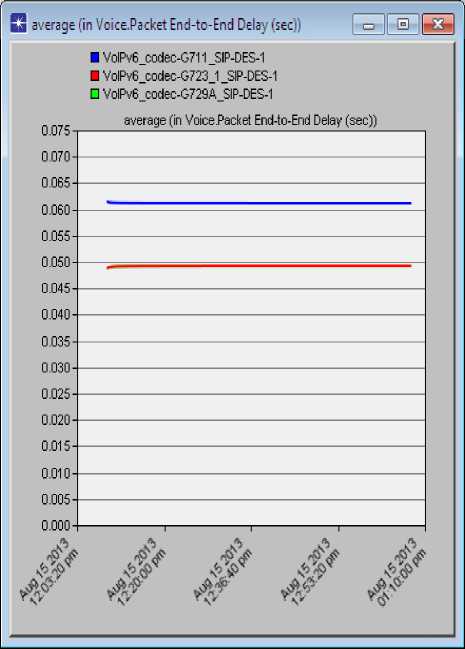
Fig 4. End-to-End Delay
-
V. Discussion of Results
The findings obtained from the simulation results are summarized in table 2 which is a comparative presentation for the three audio codecs.
The variation in performance for the audio codecs had varying level of efficiency on single parameter. Taking MOS value into consideration, G.711 had the lowest MOS value indicating possible exclusion of this codec to be used in VoIPv6 environment if compared to G.729A and G.723.1. On the other hand, G.711 had better performance in terms of jitter – G.711 had lower jitter with no exhibition of experiencing random jitter, while the other two codecs had comparatively higher jitter associated with random jitter. Though packet delay variation was lower for G.711 codec, it had higher end-to-end delay which is a crucial considering factor for deciding upon performance. The results from the study showed that the existing audio codecs were capable of performing fairly well in VoIPv6 scenarios, though further technical improvement for the codecs would be required. The codecs have their compatibility with IPv6 scenarios. If MOS and end-to-end delay are taken to be the most prioritized QoS factors to influence the decision on the most suited codec for VoIPv6 among the selected codecs, G.729A and G.723.1 could be chosen over G.711 based on the obtained results.
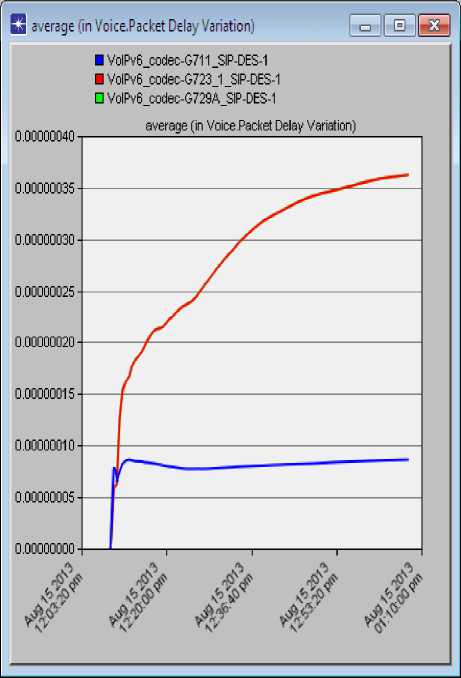
Fig 5. Packet Delay Variation
Table 2. Summary of Results
|
G.711 |
G.729A |
G.723.1 |
|
|
MOS |
3.7 |
3.8 |
3.8 |
|
Jitter |
Lower |
Higher |
Higher |
|
no random jitter |
random jitter |
random jitter |
|
|
End-to-End delay (sec) |
0.061 |
0.049 |
0.049 |
|
Packet delay variation |
Lower |
Higher |
Higher |
If the issue of choosing the best audio codec for VoIPv6 is considered, the obtained results and their comparison do not contribute much to help in reaching this decision. As depicted in table 2, the selected audio codecs have different level of performance where one codec is better in terms of any specific parameter while another codec is better in terms of another. Though G.711 can be taken to be the best suited one among the three codecs selected, the question of choosing best codec is still unresolved if the total context of VoIP and its associated technologies are taken into account. The highest suitability of G.711 audio codec is to be considered only within the context of the study presented with comparison to the rest two audio codecs.
-
VI. Conclusions and Future Development
As evident from the results and their subsequent analysis, the existing and most widely used audio codecs have the potentiality to cope well with VoIPv6 environment. This leads to the realization that the existing audio codecs would not have to be necessarily discarded despite of possible requirement of technical improvement to deploy them in IPv6 network scenarios. The study was carried out by means of simulation. It implies that the reliability of the obtained results was entirely dependent on the efficiency of the simulation tools used. It is possible to experience completely different result compared to those of practical and real life scenarios if poor and inefficient simulation tool is used. With this into consideration, it can be anticipated that the obtained results can be taken into account with fair level of reliability for the fact that the used simulation tool OPNET is already a leading simulation tool and being extensively used in research and academia.
The results based on the presented study have established the possible performance quality of VoIPv6 associated with the selected audio codecs. The networking scenarios for any VoIP or simply IP based network cannot be confined into a single set of elements and configuration, as the real life networks include number of technologies with different kinds of topologies – heterogeneity and mesh are the general arrangements that one can anticipate when considering the real life public networks for VoIP deployment, regardless of its being over IPv6 or any other IP version. The performance of any audio codec in any given network scenario and configuration might not be the optimum performance for the respective audio codec – different configuration might result in far better performance for the same audio codec. A promising and newly introduced audio codec is the Opus audio codec [23] that might demand further exploration in VoIPv6 context – an aspect that can be taken as part of the future development of the study conducted. The contemporary trend is rapidly moving towards wireless and mobile computing where the significance of audio codecs for quality experience remains as one of the most crucial factors [24, 25]. Besides, codecs have significant impact on any streaming media [26]. Thus, the performance aspects of different audio codecs are required to be experimented in different wireless networking scenarios as part of extended research on this study. While it is possible to make a long list of various parameters like routing protocols, queuing mechanisms, other audio codecs apart from those used in this study, different signalling protocols and so on to be used to deploy different networking scenario to test audio codecs’ performance for VoIPv6; it is ample to state that further study in the performance factors of VoIPv6 is open to a limitless extent.
Список литературы Audio Codecs in VoIPv6: A Performance Analysis
- Hobfeld, T. and Binzenhofer, A. Analysis of Skype VoIP Traffic in UMTS: End-to-end QoS and QoE Measurements. Computer Networks, 2008. 52: p. 650-666. doi:10.1016/j.comnet.2007.10.008.
- Chang, L., Sung, C., Chiu, S. and Lin, Y. Design and realization of ad-hoc VoIP with embedded p-SIP server. The Journal of Systems and Software, 2010. 83: p. 2536–2555. doi:10.1016/j.jss.2010.07.053.
- Toral-Cruz, H., Pathan, A. K. and Pacheco, J. R. Accurate modeling of VoIP traffic QoS parameters in current and future networks with multifractal and Markov models. Mathematical and Computer Modelling, 2013. 57: p. 2832–2845. doi:10.1016/j.mcm.2011.12.007.
- Ugale, N. V. and Parit, S. B. An Overview of SoC Platform for VOIP Application. International Journal of Emerging Trends in Engineering and Development, 2013. 3(2): p. 310-315.
- Singh, H. P., Singh, S., Singh, J. and Khan, S. A. VoIP: State of art for global connectivity—A critical review. Journal of Network and Computer Applications, 2013. http://dx.doi.org/10.1016/j.jnca.2013.02.026.
- Tadayoni, R. and Henten, A. (2012 July). Transition from IPv4 to IPv6. In 23rd European Regional ITS Conference, Vienna, Austria, July 2012.
- Al- Ani, M. S. and Haddad, R. A. A. IPv4/IPv6 Transition. International Journal of Engineering Science and Technology, 2012. 4(12): p. 4815-4822.
- Dutta, C. and Singh, R. Sustainable IPv4 to IPv6 Transition. International Journal of Advanced Research in Computer Science and Software Engineering, 2012. 2(10): p. 298-305.
- Sathu, H. and Shah, M. A. Performance Comparison of VoIP Codecs on Multiple Operating Systems using IPv4 and IPv6. International Journal of e-Education, e-Business, e-Management and e-Learning, 2012. 2(2): p. 122-125.
- Brak, S. E., Bouhorma, M., Brak, M. E. and Boudhir, A. A. Voip applications over MANET: Codec performance enhancement by tuning routing protocol parameters. Journal of Theoretical and Applied Information Technology, 2013. 50(1): p. 68-75.
- Luthra, P. and Sharma, M. Performance Evaluation of Audio Codecs using VoIP Traffic in Wireless LAN using RSVP. International Journal of Computer Applications, 2012. 40(7): p. 15-21.
- Xiaonan, W. and Shan, Z. All-IP communication between wireless sensor networks and IPv6 networks based on location information. Computer Standards & Interfaces, 2013. 35: p. 65–77. doi:10.1016/j.csi.2012.05.005.
- Hicsonmez, S., Sencar, H. T. and Avcibas, I. Audio codec identification from coded and transcoded audios. Digital Signal Processing, 2013. 23: p. 1720–1730. doi: http://dx.doi.org/10.1016/j.dsp.2013.04.005.
- Salah, K. and Alkhoraidly, A. An OPNET-based simulation approach for deploying VoIP. International Journal of Network Management, 2006. 16: p. 159–183. doi: 10.1002/nem.591.
- Lee, C., Choong, K. N., Koh, S. G., Chow, C. O. and Abbas, M. Performance Study on Audio Codec and Session Transfer of Open Source VoIP applications. World Academy of Science, Engineering and Technology, 2009. 36: p. 196-202.
- Rattal, S., Badri, A. and Moughit, M. Performance Analysis of Hybrid Codecs G.711 and G.729 over Signaling Protocols H.323 and SIP. International Journal of Computer Applications, 2013. 72(3): p. 29-33.
- Lakas, A. and Boulmalf, M. Experimental Analysis of VoIP over Wireless Local Area Networks. Journal of Communications, 2007. 2(4): p. 3-9.
- Salah, K., Calyam, P. and Buhari, M. I. Assessing readiness of IP networks to support desktop videoconferencing using OPNET. Journal of Network and Computer Applications, 2008. 31: p. 921–943. doi:10.1016/j.jnca.2007.01.001.
- Sharma, A., Varshney, M., Singh, N. K. and Shekhar, J. Performance Evaluation of VOIP: QoS Parameters. VSRD International Journal of Computer Science & Information Technology, 2011. 1(4): p. 210-221.
- Anouri, T. and Haqiq, A. Performance Analysis of VoIP Traffic in WiMAX using various Service Classes. International Journal of Computer Applications, 2012. 52(20): p. 29-34.
- Alshomrani, S., Qamar, S., Jan, S., Khan, I. and Shah, I. A. QoS of VoIP over WiMAX Access Networks. International Journal of Computer Science and Telecommunications, 2012. 3(4): p. 92-98.
- Yeh, C. and Zhuo, C. An efficient complexity reduction algorithm for G.729 speech codec. Computers and Mathematics with Applications, 2012. 64: p. 887–896. doi:10.1016/j.camwa.2012.01.048.
- Valin, J.M., Vos, K. and Terriberry, T. Definition of the Opus Audio Codec, 2012. RFC 6716.
- Kamarudin, I.E., Sharif, S.A.M. and Herawan, T. Performance Analysis on the Effect of G.729, Speex and GSM Speech Codec on 802.11g Wireless Local Area Network over VoIP using Packet Jitter. International Journal of Control and Automation, 2013. 6 (4): p. 387-395.
- Gurung, K. and Singh, H.M. Performance Analysis of Different Voice CODECs in Integrated VANET-UMTS Wireless Network by using H.323. International Journal of Current Engineering and Technology, 2013. 3 (5): p. 1750-1755.
- Oladayo, O.O. A Wireless Local Area Network Soft Cell Phone (SCP) System with Multimedia and Data Services. International Journal of Computer Network and Information Security, 2014. 6 (2): p. 9-15.

